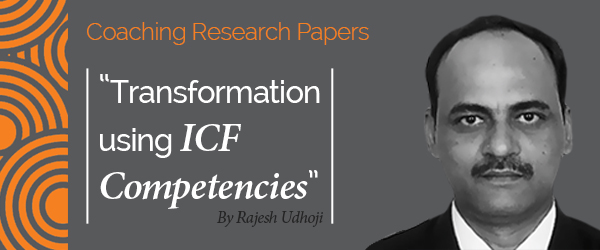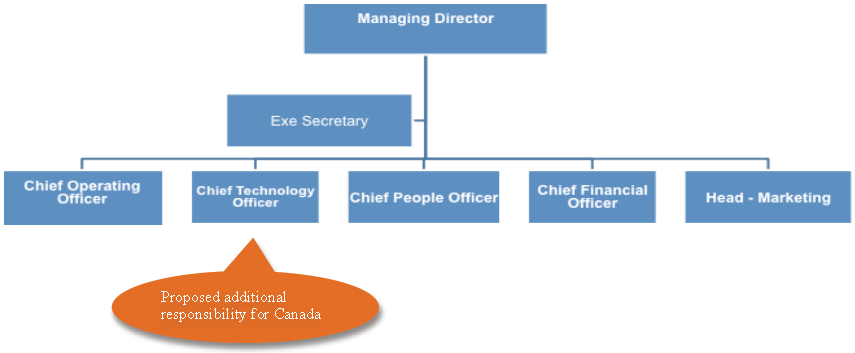Research Paper By Rajesh Udhoji
(Executive Coach, INDIA)
Introduction:
The application of Coaching theory have different applications depending on the space in which one operates and the individual styles. While, the ICF guidelines respect the individual styles within the ethical guidelines, I have made an effort to use the ICF competencies in the real life situation to bring in the desired transformation in critical resources resulting in larger benefits to the organization. This case study is based on my individual experience and I am humbly making an effort to pen it down in the form of a case study. The name of the organization and the positions described in this case are changed for the sake of brevity to ensure privacy and respect for the individual entities.
Background:
ABC limited is a family run organization based in Mumbai, India. It is in the business of Neutraceuticals. The Company on the high end of technology, providing neutraceutical ingredients in the space of eye health, brain health, anti aging and weight management. It has its research centers in India and in Canada. The Company focus is in all developed markets around the world and has primary Markets in the United States of America, Canada, Europe, Japan and various other developed Markets. Managing Director, son of the founder of the Company, heads the Company. The Managing Director is a very ambitious person and has to his credit growing the organization almost ten times in the revenue in last five years. A Chief Operating Officer, who is with the company for last 15 years, heads the Operations of the Company and the RnD is headed by a Chief Technical Officer, who is also with the Company for last nine years. Both of them report to the Managing Director.
As the company is growing exponentially, the Managing Director felt the need of creating a landscape of his Vision, Mission and Values that will help him drive the growth of the organization for next 15-20 years. He is also of the firm belief that the current way his business has been run will need a transformation to take the organization to the next level.
As a part of his preparation for the growth of the Organization, The Managing Director in his vision speech to the Top Management Team and various functional Heads of the businesses spoke about the vast potential of his business, specifically in the US, Canada and the European Market. Being in the Nutraceuticals Market space, the Organization needed to focus on Innovation, R & D, Technology up-gradation and Capacity Enhancement. The Managing Director therefore set out stringent objectives for the team reporting in to him in terms of:
a) Double the exiting production capacity by 2015.
b) Re-organize the current Organization Structure to meet the growth objectives of the organization
c) Increase our presence in US, Canada and Europe
d) In the first year, the new products to contribute 20%, second year by 30% and by the third year new products need to contribute 50% of the revenues from these Markets
e) At-least one new scalable product need to be innovated every year
Situation:
The MD called the Chief People Officer after this vision meeting. As the Chief People officer had joined recently he had shared the current Organization Structure and wanted him to re-organize the same in light of the projected growth plans. (The current top organization structure was as shown in Figure -1 below). The MD further stated that he needs the help of the Chief People Officer in resolving a long pending issue apprehending that the issue may affect his growth plans and hence it was important that the issue is addressed as quickly as possible. He shared with him that the only way the organization can keep its pace of growth is through innovation and by quickly creating new products, before the competition hits the Market. In such a competitive situation, he is expecting a significant contribution from the Research team.
Figure – 1
However, he is concerned that the Chief Technology officer has resigned from the services of the company stating that he does not have a role to play in a given situation. He also stated that possibly, Chief Technology Officer feels humiliated that the Management because of his differences has not recognized his contribution with the Top Management team members. This, he perceives as a larger potential threat to his growth plans. He also feels that Chief Technical officer is a genius in his field and hence not only needs to be retained but also needs to be given an additional responsibility of leading the Innovation Centre in Canada. He set the following Objectives for the Chief People officer to address:
Objectives
- Identify the issues related to the resignation of the Chief Technical Officer (CTO)
- Coach the CTO to appreciate interdependence and work together
- Address the issue of CTO’s resignation and seek buy in for additional contribution of responsibility in Canada OR take an appropriate decision.
Action and Application:
Over a period of about six months, various interactions took place between the Coach (the CPO) and the Chief Technology Officer (Client) and the following issues were identified:
i) His earlier request of creating the Innovation Centre at Canada was not only refused by the Management but now he is not even allowed to go to Canada.
ii) He does not have any decision-making authority
iii) He feels pressure of strained relationships with the Top Management Team Members.
Considering the above situation and the objectives set, I as the Chief People Officer (CPO) and the Coach, have made an attempt to use the ICF competencies and my learning during the ICA graduation and ICF credential journey to address the above objectives and identified issues.
A) Setting The Foundation:
5. Meeting Ethical Guidelines And Professional Standards:
At the outset, the Coach (CPO) clarified with the sponsor (MD) that the discussions with the client are Proposed additional responsibility for Canada going to be absolutely confidential in nature with all due respect to them as individual clients as well as their current role and that the discussions will remain within them. In no ways the information received during the interaction will be used for any other purpose but only for their development with a potential result of resolving the current issue faced by the organization. The MD agreed for the same.
6. Establishing The Coaching Agreement:
The Coach specified his requirements with the client (the CTO) in terms of maintaining confidentiality of the information shared during the interactions, the discipline of attending to the mutually agreed time schedules and commitment to act on the alternatives and insights they may discover during the tenure of the coach and client relationship. He also defined his role as a facilitator to help and support them identify the underlying issues and to help them develop alternatives and NOT as a solution provider.
B) Co-Creating The Relationship
1. Establishing Trust And Intimacy With The Client :
The coach defined the schedule of interactions with the client. At the beginning of the interactions, every time, he re-assured that the interactions are confidential between them. The interactions took place at a location of the clients choice with no disturbance at all so that the Coach and the client could fully concentrate on the discussions between them. Over a period of interactions, the clients experienced this commitment and this allowed him to open up with the coach and discuss issues freely without any apprehensions or fears.
The clients expressed their concerns and achievements and each of the achievement of theirs was acknowledged. This further re-enforced the trust between them and the environment became very free and constructive to discuss deeper issues involved. A healthy relationship evolved.

